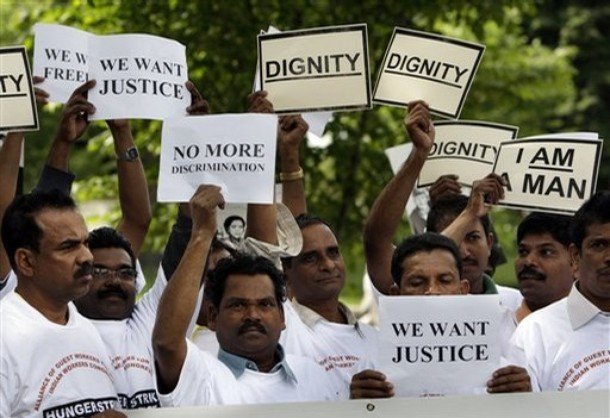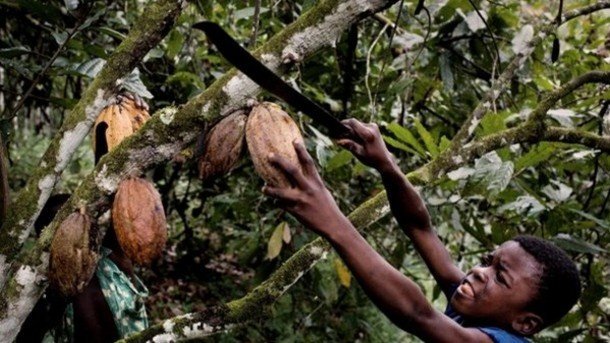In search of cheap labor, and circumventing US laws and regulations, American companies have sought cheap labor by outsourcing their production chain abroad. The outsourcing of American companies is one of the foundations that incentivizes the modern model of slavery. In a very brief outlook, we aim to reveal how modern slavery is linked to the behavior of the US government and the companies who benefit from government support.
Those people, who are being exploited by these companies, can also be considered as minorities, deprived of their rights, facing an oppressive system of slavery. The definition of minority groups given by Feagin (1984) is totally applicable to these enslaved people, fitting the description of his suggested ‘five characteristics’ that a group must possess in order to be called a minority. First, people in a minority group experience discrimination and subordination. Second, they are distinguished based on their culture and physical traits. Third, members of a minority group share a sense of identity, suffering or displacement. Fourth, the social status of members of such a group depends on rules set by the dominant group that specify who belongs and who does not belong. Fifth, regardless of their numerical majority, they are ruled by the dominant group [1]. Our analysis on the manner of treatment, by American government, given towards minorities is based on this definition, and we term that treatment as enslavement.
Modern slavery is alive and thriving, thanks to US policies around the world [2]. During the era of chattel slavery, the cost of purchasing a slave was around $40,000 (adjusting for modern inflation), but today slaves are much more affordable. Today, anyone can buy a slave at around one hundred US dollars, or a mere fifty dollars. In previous times, in American history, a slave owner saw a slave as an investment, unlike the current conditions of modern slavery, where a slave is seen as a disposable item due to the low price of human life. While “slavery” or the condition whereby one person “owns” another person, as if he or she were an animal or a piece of inanimate property, is now illegal. The policies, whereby humans are not paid their full worth or held captive, against their will, to perform work for a boss (whether individual or corporation) is all too common. According to Kevin Bales, professor of Contemporary Slavery at the Wilberforce Institute for the Study of Slavery and Emancipation at the University of Hull in Great Britain, an estimated 14,000--17,000 persons are trafficked into the United States every year and forced to work within American borders, under threat of violence for no pay beyond subsistence[3]. This number should be added to the legal enslavement of guest workers who come to the US under the H-2B visa program; this group may reach as high as 60,000 people per year.

These numbers are not limited to workers within America’s borders, as US companies have started to outsource their businesses to other parts of the world where much of the labor force comes from highly impoverished areas, and are forced to work to maintain a minimal degree of survival for their families. The amount of their wages, actually, points to a systemic exploitation of human labor, and can be described as a form of slavery. The reports of how much a worker is paid vary, from company to company, but workers assembling Apple iPhones, for example, work 11 hours a day for 6 days a week and receive $1.50 an hour, which equals $268 per month. This wage is far below the living wage necessary to live in Shanghai [4].
According to the Bureau of Labor Statistics, the average hourly wage for Chinese manufacturing workers is less than a tenth of that of their average US counterparts [5]. Further worsening this scenario, Chinese workers are three times more likely to die on the job, compared to American workers [6].
Outsourcing began from the outsourcing of jobs in the US; subcontractors charged lower prices, in addition owners were not responsible for workers. In 1911, 146 workers died at the Triangle Shirtwaist factory in New York City, when their building caught on fire. These people were burning before the very eyes of the customers, who purchased the clothing they made. This horrible event led to consumer and political activism to ensure that this kind of incident did not happen again. As a result, many safety measures were levied on business owners, they had to provide for their workers to prevent such events. These measures became workplace safety standards. This move was the cornerstone for later changes that brought better living conditions for workers in America, such as the minimum wage, the 8-hour day, child labor laws, workers’ compensation, Social Security. Later, in attempts to reduce the negative environmental impact of manufacturing companies on the general public, the Clean Air Act and the Clean Water Act were passed, creating further limitations on American business owners.
In order to evade such necessary regulations, business executives started to outsource their businesses in foreign countries where such laws and regulations are weaker or do not exist at all. This response from the corporations was to safeguard their interest in exploitation of cheap labor. American companies are now in control of a huge, cheap workforce in Asia and Central America. By doing this, they not only escaped American safety and environmental regulations, but also they have access to very cheap labor force. According to Erik Loomis, an assistant professor of history at the University of Rhode Island and a blogger activist on labor and environmental issues, the 2013 incident at Rana Plaza in Bangladesh that killed 1100 people is also to be blamed on US companies; the same industry, the same subcontracted system[7]. According to Loomis, we have to ask which American or European companies were using the labor force at Rana Plaza in Bangladesh; in this case, sweatshops for Benetton, Canadian Joe Fresh, Walmart, J.C. Penny and the British Primar were involved in the substandard conditions which precipitated the devastating fire.

All these companies could have built their own factories, or conducted inspections of the factories with which they formed a contract, but instead they chose low costs. Indeed, US and European companies fund this system of slavery and incentivize factory owners to profit from cutting corners. The blame for outsourcing the work by US and European companies lies not only with the business owners; the respective governments are also behind the owners, in facilitating the process of enslaving other nations via trade deals and economic agreements. The most blatant example of this is the Trans-Pacific Partnership (TPP), it allows US companies to take advantage of cheap labor in these countries. Latin-American people took to the streets in a bid to demand that their National Congress revoke this exploitative deal [8].
American slavery is not limited to American borders, and has taken multiple forms. Many US and European companies work with industries that use child or adult slaves in the manufacture of their products. For example, the shrimp that Americans buy at Walmart, Carrefour, Costco and Tesco are processed by slaves in Thailand. You may say Thailand is to be blamed, for slavery that occurs inside its borders, but also bear in mind which countries are financing the slavery there. The increased demands from the United States and Europe indicate that 300,000 people in the Thai fishing industry actually work for American and European retailers [9].
In this big business of slavery children are great assets; they were found sewing clothing for Walmart, Hanes and European companies [10]. Children were also found to work at chocolate factories on a large scale [11]; these chocolate companies include Hershey, Mars, Nestle, ADM Cocoa, Godiva, Fowler’s Chocolate and Kraft [12]. These companies continue their child slave trend as this article is being written. Recently in Africa, children that worked for companies sponsored by Apple, Microsoft and others, created a big controversy for the support these companies are making off of child slavery in Congo[13]. The use of child labor has become so obvious that Nestle executives have admitted to the use of this practice [14]. There are numerous other examples of how corporations outsource catastrophe and workers’ pay the price[15].

Enslaving people is not limited to American and European countries, but their respective governments also have a great share in the slave labor. There are many reports pointing to military contracts of human trafficking, which were carried out in Iraq and Afghanistan [16]. The reports show how the US military has abused Third country nationals at their military bases and exploited them as cheap labor [17].
Whether directly or indirectly, the government of America is involved in the enslavement of people around the world for the annual profit they bring home to US corporations. While some may argue that slavery is not particular to the US, due to the huge turnover seen in American companies, they depend heavily on cheap labor to keep their products competitive in the global market. From this, it can be concluded that this system of slavery is a byproduct of modern capitalism and neoliberal policies, which have led to the accumulation of wealth in the hands of a few while leaving the rest worse off, in spite of working long hours in often dangerous conditions.
[1] Hodgetts, Darrin, et al., et al. Social Psychology and Everyday Life. s.l. : Palgrave Macmillan, 2010. Available at: https://books.google.com/books?id=0ugcBQAAQBAJ&pg=PA135&dq.
[2] Slavery: Alive and well in the 21st century. Aljazeera. [Online] 10 10, 2011. [Cited: 01 23, 2016.] http://www.aljazeera.com/programmes/slaverya21stcenturyevil/2011/10/2011109135233564570.html
[3] Bales, Kevin. There Are More Slaves Today Than at Any Time in Human History. Ben Skinner spent four years inside the world of modern-day slavery; an industry that produces huge profits and countless wasted lives. s.l. : AlterNet, 08 24, 2009
[4] Smith, Kevin. Chinese Workers Making iPhones Work 11-Hour Shifts, 6 Days A Week, For $1.50 Per Hour. Business Insider. [Online] 07 29, 2013. [Cited: 01 25, 2016.] http://www.businessinsider.com/china-labor-watch-apple-iphone-workers-2013-7
[5] International Labor Comparisons; Manufacturing in China. s.l. : Bureau of Labor Statistics, 2009. Available at: http://www.bls.gov/ilc/china.htm#data_tables
[6] Kavoussi, Bonnie. Average Cost Of A Factory Worker In The U.S., China And Germany [INFOGRAPHIC]. Huffington Post. [Online] 03 19, 2012. [Cited: 01 25, 2016.] http://www.huffingtonpost.com/2012/03/08/average-cost-factory-worker_n_1327413.html.
[7] Loomis, Erik. “No one is making them stop”: Why corporations outsource catastrophe — and workers pay the price . Labor historian Erik Loomis illuminates the warped economic order that exploits the global poor. 07 06, 2015.
[8] South America Takes to the Streets Against TPP. teleSUR. [Online] 01 23, 2016. [Cited: 01 25, 2016.] http://www.telesurtv.net/english/news/South-America-Takes-to-the-Streets-Against-TPP--20160123-0017.html.
[9] Hodal, Kate, Kelly, Chris and Lawrence, Felicity. Revealed: Asian slave labour producing prawns for supermarkets in US, UK . The Guardian. [Online] 06 10, 2014. [Cited: 01 23, 2016.] http://www.theguardian.com/global-development/2014/jun/10/supermarket-prawns-thailand-produced-slave-labour.
[10] Unknown. Children Found Sewing Clothing For Wal-Mart, Hanes & Other U.S. & European Companies . The Labor & Worklife Program at Harvard Law School. [Online] [Cited: 01 23, 2016.] http://www.law.harvard.edu/programs/lwp/NLC_childlabor.html.
[11] Haglage, Abby. Lawsuit: Your Candy Bar Was Made By Child Slaves. The Daily Beast. [Online] 09 30, 2015. [Cited: 01 23, 2016.] http://www.thedailybeast.com/articles/2015/09/30/lawsuit-your-candy-bar-was-made-by-child-slaves.html.
[12] Wellman, Nathan. Beware of These 7 Popular Chocolate Brands that Exploit Child Slaves. US Uncut. [Online] 10 31, 2015. [Cited: 01 23, 2016.] http://usuncut.com/news/beware-of-these-10-popular-chocolate-brands-that-exploit-child-slaves/.
[13] RT. Apple, Microsoft allegedly use cobalt sourced from child labor in DR Congo – Amnesty. RT. [Online] 01 19, 2016. [Cited: 01 19, 2016.] https://www.rt.com/news/329420-amnesty-cobalt-child-labor-apple/.
[14] Nestle Admits To Slave Labor, May Prompt Other Companies To Come Clean. huffingtonpost. [Online] 11 25, 2015. [Cited: 01 23, 2016.] http://www.huffingtonpost.com/entry/nestle-admits-to-using-slave-labor-groups-hope-other-companies-will-come-forward_us_5655cec6e4b08e945fea9729.
[15] Kaufman, Scott Eric. “No one is making them stop”: Why corporations outsource catastrophe — and workers pay the price . Salon. [Online] 07 06, 2015. [Cited: 01 23, 2016.] http://www.salon.com/2015/07/06/no_one_is_making_them_stop_why_corporations_outsource_catastrophe_and_workers_pay_the_price/.
[16] Lowenstein, Allard K. Victims of Complacency: The Ongoing Trafficking and Abuse of Third Country Nationals by U.S. Government Contractors. New York : American Civil Liberties Union, 2012. Available at: https://www.aclu.org/report/victims-complacency-ongoing-trafficking-and-abuse-third-country-nationals-us-government?redirect=human-rights/victims-complacency-ongoing-trafficking-and-abuse-third-country-nationals-us-government.
[17] Watt, Steven M. "Victims of Complacency": Trafficking and Abuse of Migrant Workers on U.S. Military Bases. American Civil Librty Union. [Online] 06 28, 2012. [Cited: 01 23, 2016.] https://www.aclu.org/blog/victims-complacency-trafficking-and-abuse-migrant-workers-us-military-bases?redirect=blog/human-rights-national-security/victims-complacency-trafficking-and-abuse-migrant-workers-us.




